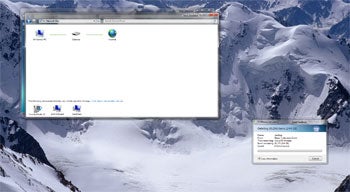
The Challenge
Switch from Windows Vista to Windows 7 completely. No going back to work with compatible programs. No jumping ship if a driver keeps you away from your Warhammer Online character. No tears. Windows 7 is your new home for 72 hours, starting from your initial download of the software.
The Spoiler
Microsoft doesn't know how to manage digital downloads. Nor does Microsoft know how to title its own applications--this isn't Windows 7, not by any means. It's Windows Vista SP2.
The Tribulation
Having completed my 72 hours in Windows 7 land, I'm going to adopt the same mindset and cap the writing of this post at one hour's length. Having seen no less than 40 different articles about Windows 7 over the past three days (if not three months), I'm not about to bore you with a list of the 89 most important features Windows 7 brings to the table. What I am going to chat about is what the actual process of jumping to Windows 7 is like. What happens? How do the new features of Windows 7 affect the general usage patterns of an operating system? What's the speed like? Why would I buy this to replace Vista?
I'll start with a cursory note that this article was actually supposed to run Monday morning--the whole concept of "72 hours in Windows 7 Land" being a fun little weekend activity that I would write up and post for all the people who gave up on downloading the beta on its horrible Friday release. About that. Seeing as Microsoft has no idea what "busy servers" entails, and apparently refuses to release its beta clients across a peer-to-peer distribution method a la Blizzard game patches, I waited. And waited. And waited, until I finally acquired a copy of Windows 7 well into Saturday afternoon. Leading the charge into the digital future, that's Microsoft.
Ahem.
I fired up Windows 7 on a drive I had pre-partitioned in preparation for the event. On one half sat a fresh installation of Windows Vista featuring all the latest updates and drivers I could get my hands on. On the other would sit Windows 7, as I wanted to compare the two's initial performance before installing a ton of my typical junk on either. I fired up my Windows 7 ISO and let 'er rip.
The Installation
 Installing Windows 7 (x64) brought a tear to my eye, for I do love nostalgia and this installation routine is virtually a carbon-copy of Windows Vista's. Save for the addition of a new setup screen for establishing a Homegroup--Windows 7's answer to network file-sharing--there's nothing dramatic about the installation in the slightest. Compared to Windows XP, both Vista and 7's installation procedure (side note: I hope this never becomes the nickname for the operating system) are a godsend. But I'd love to see a more streamlined installation: Perhaps a way to set all the options you need to set up-front, so you can just sit back and let the 24:01-minute process do it's thing. I love making customized slipstream OS installation discs for this very fact. Convenience, Microsoft. Convenience!
Installing Windows 7 (x64) brought a tear to my eye, for I do love nostalgia and this installation routine is virtually a carbon-copy of Windows Vista's. Save for the addition of a new setup screen for establishing a Homegroup--Windows 7's answer to network file-sharing--there's nothing dramatic about the installation in the slightest. Compared to Windows XP, both Vista and 7's installation procedure (side note: I hope this never becomes the nickname for the operating system) are a godsend. But I'd love to see a more streamlined installation: Perhaps a way to set all the options you need to set up-front, so you can just sit back and let the 24:01-minute process do it's thing. I love making customized slipstream OS installation discs for this very fact. Convenience, Microsoft. Convenience!
Both installation processes forced two resets on my computer. And for those keeping score at home, the Vista installation took all of three minutes, twenty-six seconds less time than the Windows 7 installation. That's not a lot minute-wise, but it's still 16 percent more time than its predecessor. I'm also running a pretty souped-up PC--a stock-clocked Intel QX9650 running at 3.0GHz, four gigabytes of RAM, a speedy Western Digital terabyte hard drive, and an ATI Radeon HD 4850 video card. I can only imagine how long Windows 7 might take for a machine of less prowess.
Getting Started
A nice touch of Windows 7 is that it installed with more drivers configured than its predecessor. My Windows Vista installation came with five unknown devices attached, requiring me to find and install drivers for the video card and Ethernet drivers for the motherboard in particular. Windows 7 set itself to the highest resolution my monitor supports using what appeared to be Microsoft-friendly ATI drivers. My Internet connection "worked" immediately, allowing me to fetch whatever I needed without having to first find the CD that came with my motherboard. Nice.
 (Ethernet woes aside, I like how Windows 7 now gives you a "files processed per second" time instead of a "Megabytes of speed" value.)
(Ethernet woes aside, I like how Windows 7 now gives you a "files processed per second" time instead of a "Megabytes of speed" value.)
Further inspection of the Ethernet drivers revealed that these were less than stable for my system. I had horrific problems trying to make multiple connections to either the Internet or my network devices. The operating system froze up every time I tried to grab more than one batch of files from my NAS, download files from the NAS and Steam at once, or generally do anything but surf the Web. Frustrated, I went back to the my motherboard's CD drivers and that seemed to fix the problem just fine. This now-stable OS was ready to get used!
